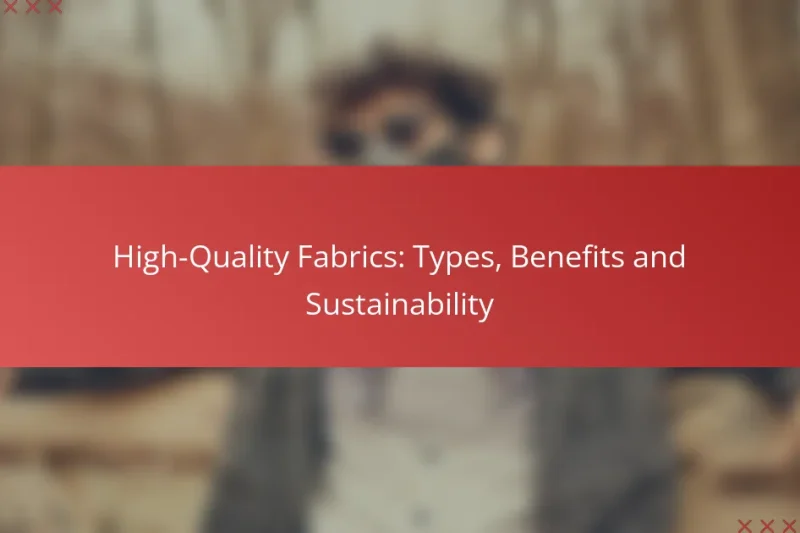High-quality fabrics such as cotton, linen, silk, wool, and cashmere provide unique benefits that enhance durability, … High-Quality Fabrics: Types, Benefits and SustainabilityRead more
Quality and Craftsmanship in Streetwear
Quality and craftsmanship are essential elements in the world of streetwear, where the choice of materials and construction methods significantly impact the overall appeal and longevity of garments. High-quality streetwear not only showcases style but also emphasizes durability and comfort, making it a worthwhile investment for fashion enthusiasts. Renowned brands like Supreme, Off-White, and Fear of God exemplify this commitment, setting high standards in design and production that resonate with consumers seeking both aesthetic and functional excellence.
Artisanal Techniques: Craftsmanship, Tradition and Innovation
Artisanal techniques play a crucial role in enhancing craftsmanship by marrying skill and tradition with innovation. … Artisanal Techniques: Craftsmanship, Tradition and InnovationRead more
Ethical Manufacturing: Standards, Impact and Transparency
Ethical manufacturing encompasses standards that prioritize fair labor practices, environmental sustainability, and social accountability. As consumers … Ethical Manufacturing: Standards, Impact and TransparencyRead more
Counterfeit Streetwear: Identification, Risks and Buyer Tips
Counterfeit streetwear is a growing concern for fashion enthusiasts, as it can lead to financial loss … Counterfeit Streetwear: Identification, Risks and Buyer TipsRead more
Consumer Reviews: Key Factors, Insights and Trends
Consumer reviews play a crucial role in shaping purchasing decisions, as they can significantly influence perceptions … Consumer Reviews: Key Factors, Insights and TrendsRead more
High-End vs. Budget Streetwear: Quality Standards and Value
The debate between high-end and budget streetwear revolves around quality standards and value. While high-end brands … High-End vs. Budget Streetwear: Quality Standards and ValueRead more
Durability Assessment: Materials, Construction and Longevity
Durability assessment is crucial for understanding the longevity of materials used in construction, as it involves … Durability Assessment: Materials, Construction and LongevityRead more
How is quality defined in streetwear?
Quality in streetwear is defined by the materials used, the construction methods employed, and the reputation of the brand. High-quality streetwear combines durability, style, and comfort, ensuring that garments not only look good but also withstand wear over time.
Material selection
Material selection is crucial in determining the overall quality of streetwear. Premium fabrics like cotton, denim, and technical synthetics are often preferred for their durability and comfort. Brands may also incorporate sustainable materials, which can enhance both quality and appeal to environmentally conscious consumers.
When assessing material quality, consider factors such as weight, texture, and breathability. For instance, heavier cotton may indicate durability, while lightweight fabrics might offer better comfort in warmer climates.
Construction techniques
Construction techniques significantly impact the longevity and fit of streetwear. High-quality garments often feature reinforced stitching, double seams, and attention to detail in finishing. These techniques help prevent wear and tear, ensuring that the clothing maintains its shape and integrity over time.
Look for features like hidden seams and quality zippers, which can indicate a higher level of craftsmanship. Brands that prioritize construction typically offer a better fit and more refined look, enhancing the overall appeal of the piece.
Brand reputation
Brand reputation plays a vital role in defining quality in streetwear. Established brands with a history of craftsmanship and innovation are often trusted for their quality. Consumers tend to gravitate towards brands that have built a strong identity and are known for their commitment to excellence.
Researching customer reviews and brand history can provide insights into quality. Brands that consistently receive positive feedback regarding their materials and construction techniques are likely to deliver high-quality streetwear. Additionally, collaborations with reputable designers can further enhance a brand’s standing in the market.
What craftsmanship standards should you look for in streetwear?
When evaluating craftsmanship in streetwear, focus on the quality of materials, construction techniques, and attention to detail. High-quality streetwear should exhibit durability, aesthetic appeal, and a well-thought-out design that enhances both function and style.
Stitching quality
Stitching quality is crucial in determining the durability and overall appearance of streetwear. Look for tight, even stitches without loose threads or fraying. Double stitching or reinforced seams can indicate a higher level of craftsmanship, especially in areas subject to stress, like armholes or waistbands.
Common types of stitching to consider include flatlock and chain stitch, which provide flexibility and strength. Inspecting the stitching can help you identify well-made garments that will withstand regular wear and tear.
Finishing details
Finishing details can significantly impact the overall quality of streetwear. Pay attention to elements like hems, tags, and zippers. A well-finished hem should be clean and secure, while tags should be neatly sewn and not irritate the skin.
Consider hardware quality as well; zippers should glide smoothly and not snag. Additional features like reinforced buttonholes or custom labels can also indicate a commitment to craftsmanship.
Fit and sizing
Fit and sizing are essential for both comfort and style in streetwear. Look for brands that offer a range of sizes and provide detailed sizing charts to ensure a proper fit. A good fit should allow for ease of movement without being overly baggy or tight.
Consider the intended style when assessing fit; oversized silhouettes are popular in streetwear, but ensure that the proportions remain flattering. Trying on garments or checking return policies can help avoid sizing issues and ensure you find the perfect fit.
Which brands exemplify quality and craftsmanship in streetwear?
Several brands are recognized for their commitment to quality and craftsmanship in streetwear, setting high standards in materials, design, and production. Notable examples include Supreme, Off-White, and Fear of God, each known for their unique approaches to creating durable and stylish apparel.
Supreme
Supreme is a leading name in streetwear, celebrated for its limited releases and high-quality materials. The brand often collaborates with artists and designers, ensuring that each piece is not only fashionable but also crafted with attention to detail.
When considering Supreme, it’s important to note the resale market, where items can appreciate significantly in value. Many fans are willing to pay premium prices, sometimes exceeding original retail by several times, reflecting the brand’s desirability and craftsmanship.
Off-White
Off-White, founded by Virgil Abloh, merges streetwear with high fashion, emphasizing quality construction and innovative designs. The brand is known for its distinctive use of quotation marks and industrial motifs, which have become iconic in the fashion world.
Off-White products often feature premium fabrics and meticulous stitching, making them a worthwhile investment for those seeking both style and durability. Keep an eye on the brand’s seasonal drops, as limited editions can quickly sell out and become highly sought after.
Fear of God
Fear of God focuses on luxury streetwear, combining high-quality materials with a minimalist aesthetic. The brand is recognized for its oversized silhouettes and neutral color palette, appealing to those who appreciate understated elegance.
When purchasing Fear of God items, consider the craftsmanship that goes into each piece, often including intricate details and high-end fabrics. This attention to quality can justify the higher price point, making it a solid choice for those looking to invest in timeless streetwear pieces.
How does streetwear quality impact pricing?
The quality of streetwear significantly influences its pricing. Higher quality materials and craftsmanship typically lead to increased costs, which are reflected in the retail price of the garments.
Material costs
Material costs are a primary factor in determining the price of streetwear. Premium fabrics such as organic cotton, high-grade denim, or innovative synthetic blends can significantly elevate production expenses. For instance, a basic t-shirt might cost around $5 to produce with standard materials, while one made from luxury fabrics could exceed $20.
Additionally, sourcing sustainable or ethically produced materials often involves higher costs, which brands may pass on to consumers. Shoppers should consider the type of materials used when evaluating the price of streetwear items.
Labor expenses
Labor expenses play a crucial role in the overall cost of streetwear. Brands that prioritize skilled craftsmanship and ethical labor practices may incur higher wages, which can lead to increased retail prices. For example, garments made in countries with higher labor standards, such as those in Western Europe or North America, often come with a premium compared to those produced in regions with lower labor costs.
Moreover, the complexity of the design and construction can affect labor costs. Intricate designs or limited-edition releases may require more skilled labor, further driving up the price.
Brand positioning
Brand positioning significantly impacts streetwear pricing. Established brands with a strong reputation for quality and exclusivity often command higher prices due to perceived value. For instance, a well-known streetwear label may price a hoodie at $150, while a lesser-known brand might offer a similar item for $50.
Additionally, marketing strategies and collaborations with artists or influencers can enhance a brand’s image, justifying higher price points. Consumers should assess whether the brand’s positioning aligns with their expectations for quality and craftsmanship when making a purchase decision.
What are the key trends in streetwear craftsmanship?
Key trends in streetwear craftsmanship focus on sustainability, artisanal production methods, and the appeal of limited editions. These elements reflect a growing consumer demand for quality and uniqueness, setting a new standard in the industry.
Sustainable materials
Sustainable materials are increasingly prioritized in streetwear, with brands opting for organic cotton, recycled polyester, and innovative fabrics like Tencel. This shift not only reduces environmental impact but also appeals to eco-conscious consumers.
When selecting sustainable materials, consider certifications such as Global Organic Textile Standard (GOTS) or OEKO-TEX, which ensure responsible sourcing and production practices. Brands that successfully integrate these materials often command higher loyalty from their customer base.
Artisanal production
Artisanal production emphasizes craftsmanship and attention to detail, often involving small-scale manufacturing processes. This approach allows for unique designs and higher quality, distinguishing brands in a crowded market.
Look for brands that highlight their artisanal methods, such as hand-stitching or local sourcing, which can enhance the perceived value of the garments. Supporting these brands not only promotes craftsmanship but also contributes to local economies.
Limited editions
Limited editions create a sense of exclusivity and urgency, driving demand among streetwear enthusiasts. By releasing small quantities of unique designs, brands can maintain a buzz and encourage quick purchases.
Consider the resale market when evaluating limited editions, as certain drops can significantly increase in value over time. However, be cautious of hype-driven purchases; ensure that the piece aligns with your personal style and values before investing.
How can consumers assess streetwear quality before purchasing?
Consumers can assess streetwear quality by examining materials, construction, and brand reputation. Key indicators include fabric type, stitching details, and feedback from other buyers.
Online reviews
Online reviews are a valuable resource for evaluating streetwear quality. They provide insights from previous customers about their experiences with specific items, including durability, fit, and overall satisfaction.
When reading reviews, look for patterns in feedback. If multiple reviewers mention issues like poor stitching or fabric pilling, it may indicate a quality concern. Pay attention to both positive and negative comments to get a balanced view.
Consider the credibility of the review platform. Established sites with verified purchases often provide more reliable feedback than unverified sources. Additionally, reviews that include photos can offer a clearer picture of the product’s quality.






